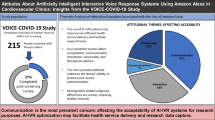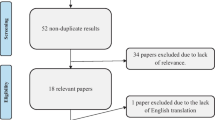Abstract
In primary care settings, follow-up regarding the outcome of acute outpatient visits is largely absent. We sought to develop an automated interactive voice response system (IVRS) for patient follow-up with feedback to providers capable of interfacing with multiple pre-existing electronic medical records (EMRs). A system was designed to extract data from EMRs, integrate with the IVRS, call patients for follow-up, and provide a feedback report to providers. Challenges during the development process were analyzed and summarized. The components of the technological solution and details of its implementation are reported. Lessons learned include: (1) Modular utilization of system components is often needed to adapt to specific clinic workflow and patient population needs (2) Understanding the local telephony environment greatly impacts development and is critical to success, and (3) Ample time for development of the IVRS questionnaire (mapping all branching paths) and speech recognition tuning (sensitivity, use of barge-in tuning, use of “known voice”) is needed. With proper attention to design and development, modular follow-up and feedback systems can be integrated into existing EMR systems providing the benefits of IVRS follow-up to patients and providers across diverse practice settings.


Similar content being viewed by others
References
[No authors listed]. Fewer bells and whistles, but IVR (interactive voice response) gets the job done. Dis. Manag. Advis. 7(9) 129–133, 2001.
Abu-Hasaballah, K., James, A., and Aseltine, R. H., Jr., Lessons and pitfalls of interactive voice response in medical research. Contemp. Clin. Trials 28(5):593–602, 2007.
Oake, N., Jennings, A., van Walraven, C., and Forster, A. J., Interactive voice response systems for improving delivery of ambulatory care. Am. J. Manag. Care 15(6):383–391, 2009.
Pierce G. IVR (interactive voice response) me ASAP. Four hot applications of interactive voice response. Healthc. Inform. 15(2) 147–148, 150, 152, 1998.
Schroder, K. E., and Johnson, C. J., Interactive voice response technology to measure HIV-related behavior. Curr. HIV/AIDS Rep. 6(4):210–216, 2009.
Shaw, W. S., and Verma, S. K., Data equivalency of an interactive voice response system for home assessment of back pain and function. Pain Res. Manag. 12(1):23–30, 2007.
Andersson, C., Soderpalm Gordh, A. H., and Berglund, M., Use of real-time interactive voice response in a study of stress and alcohol consumption. Alcohol. Clin. Exp. Res. 31(11):1908–1912, 2007.
Artinian, N. T., Telehealth as a tool for enhancing care for patients with cardiovascular disease. J. Cardiovasc. Nurs. 22(1):25–31, 2007.
Bender, B. G., Apter, A., Bogen, D. K., Dickinson, P., Fisher, L., Wamboldt, F. S., and Westfall, J. M., Test of an interactive voice response intervention to improve adherence to controller medications in adults with asthma. J. Am. Board. Fam. Med. 23(2):159–165, 2010.
Cranford, J. A., Tennen, H., and Zucker, R. A., Feasibility of using interactive voice response to monitor daily drinking, moods, and relationship processes on a daily basis in alcoholic couples. Alcohol. Clin. Exp. Res. 34(3):499–508, 2010.
Haas, J. S., Iyer, A., Orav, E. J., Schiff, G. D., and Bates, D. W., Participation in an ambulatory e-pharmacovigilance system. Pharmacoepidemiol. Drug. Saf. 19(9):961–969, 2010.
Kaminer, Y., Litt, M. D., Burke, R. H., and Burleson, J. A., An interactive voice response (IVR) system for adolescents with alcohol use disorders: a pilot study. Am. J. Addict. 15(Suppl 1):122–125, 2006.
Kashner, T. M., Trivedi, M. H., Wicker, A., Fava, M., Greist, J. H., Mundt, J. C., Shores-Wilson, K., Rush, A. J., and Wisniewski, S. R., Voice response system to measure healthcare costs: a STAR*D report. Am. J. Manag. Care 15(3):153–162, 2009.
Reidel, K., Tamblyn, R., Patel, V., and Huang, A., Pilot study of an interactive voice response system to improve medication refill compliance. BMC Med. Inform. Decis. Mak. 8:46, 2008.
Oake, N., van Walraven, C., Rodger, M. A., and Forster, A. J., Effect of an interactive voice response system on oral anticoagulant management. CMAJ 180(9):927–933, 2009.
Piette, J. D., Interactive voice response systems in the diagnosis and management of chronic disease. Am. J. Manag. Care 6(7):817–827, 2000.
Sinadinovic, K., Wennberg, P., and Berman, A. H., Population screening of risky alcohol and drug use via Internet and Interactive Voice Response (IVR): A feasibility and psychometric study in a random sample. Drug Alcohol Depend. 114(1):55–60, 2010.
Certification Commission for Health Information Technology. http://www.cchit.org/about). Accessed 13 March 2011.
Crawford, A. G., Sikirica, V., Goldfarb, N., Popiel, R. G., Patel, M., Wang, C., Chu, J. B., and Nash, D. B., Interactive voice response reminder effects on preventive service utilization. Am. J. Med. Qual. 20(6):329–336, 2005.
Farzanfar, R., Stevens, A., Vachon, L., Friedman, R., and Locke, S. E., Design and development of a mental health assessment and intervention system. J. Med. Syst. 31(1):49–62, 2007.
Kobak, K. A., Greist, J. H., Jefferson, J. W., Mundt, J. C., and Katzelnick, D. J., Computerized assessment of depression and anxiety over the telephone using interactive voice response. MD Comput. 16(3):64–68, 1999.
Levin, E., and Levin, A., Evaluation of spoken dialogue technology for real-time health data collection. J. Med. Internet. Res. 8(4):e30, 2006.
Moore, H. K., Wohlreich, M. M., Wilson, M. G., Mundt, J. C., Fava, M., Mallinckrodt, C. H., and Greist, J. H., Using daily interactive voice response assessments: to measure onset of symptom improvement with duloxetine. Psychiatry (Edgmont) 4(3):30–38, 2007.
Mundt, J. C., Bohn, M. J., King, M., and Hartley, M. T., Automating standard alcohol use assessment instruments via interactive voice response technology. Alcohol. Clin. Exp. Res. 26(2):207–211, 2002.
Mundt, J. C., Ferber, K. L., Rizzo, M., and Greist, J. H., Computer-automated dementia screening using a touch-tone telephone. Arch. Intern. Med. 161(20):2481–2487, 2001.
Mundt, J. C., Greist, J. H., Gelenberg, A. J., Katzelnick, D. J., Jefferson, J. W., and Modell, J. G., Feasibility and validation of a computer-automated Columbia-Suicide Severity Rating Scale using interactive voice response technology. J. Psychiatr. Res. 44(16):1224–1228, 2010.
Mundt, J. C., Moore, H. K., and Bean, P., An interactive voice response program to reduce drinking relapse: a feasibility study. J. Subst. Abuse Treat. 30(1):21–29, 2006.
Piette, J. D., Kerr, E., Richardson, C., and Heisler, M., Veterans Affairs research on health information technologies for diabetes self-management support. J. Diabetes Sci. Technol. 2(1):15–23, 2008.
Stuart, G. W., Laraia, M. T., Ornstein, S. M., and Nietert, P. J., An interactive voice response system to enhance antidepressant medication compliance. Top Health Inf. Manage 24(1):15–20, 2003.
Acknowledgments
This project was supported by grant number HS017060 from the Agency for Healthcare Research and Quality (Eta S. Berner, EdD, Principal Investigator).
Integrity of Research and Reporting
Ethical Standards: The experiments/research conducted and discussed here in comply with the current laws of the United States of America, the country in which the research was conducted. This study was approved by the Institutional Review Board of the University of Alabama at Birmingham.
Conflicts of Interest
CDNA is copyrighted by the University of Alabama at Birmingham. James Willig, Marc Krawitz, Anantachai Panjamapirom, Midge Ray and Eta Berner are inventors of CDNA. The other co-authors declare that they have no conflicts of interest.
Author information
Authors and Affiliations
Corresponding author
Additional information
Author’s Contributions
All authors contributed to aspects of the design and implementation of the IVRS system, participated in revision of key intellectual content in the present manuscript and approved the final submitted version.
Mark Cohen is now retired from United Cerebral Palsy where this study was conducted.
Rights and permissions
About this article
Cite this article
Willig, J.H., Krawitz, M., Panjamapirom, A. et al. Closing the Feedback Loop: An Interactive Voice Response System to Provide Follow-up and Feedback in Primary Care Settings. J Med Syst 37, 9905 (2013). https://doi.org/10.1007/s10916-012-9905-4
Received:
Accepted:
Published:
DOI: https://doi.org/10.1007/s10916-012-9905-4




